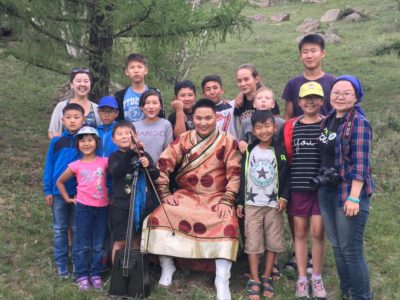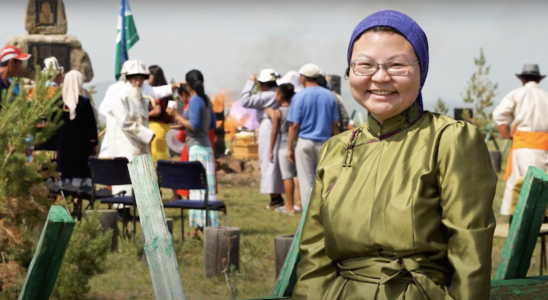Indigenous Conservationist and Snow Leopard Activist Wins Stanford’s Top Environmental Award
(Originally published in Stanford Report on September 28, 2020)
Maria Azhunova, winner of the 2020 Bright Award, supports the intergenerational transfer of traditional knowledge and biocultural approaches to nature conservation through her work at the Baikal Buryat Center for Indigenous Cultures.
From her family’s ancient homeland in the mountainous region of the Buryat Republic in Southern Siberia, Russia, Maria Azhunova harnesses generations of her people’s Indigenous knowledge to preserve Buryat culture and biodiversity across a vast multinational region of Central Asia – including the preservation of critically endangered snow leopards in direct cooperation with local peoples, youth education programs focused on sustaining Buryat language and traditional lifeways, and the reintroduction of an ancient Indigenous Buryat cattle breed once believed to be extinct. Azhunova does this work as executive director of the Baikal Buryat Center for Indigenous Cultures (BBCIC) and as director-elect of a unique multinational conservation collaborative, the Land of the Snow Leopard Network (LOSL).
“I received incredible gifts from my elders and always feel the subtle guidance of my ancestors, both the nearest ones and those who were born hundreds of years earlier than myself,” said Azhunova, who is a member of Buura clan of the Ekhirit tribe from her father’s side and the Khongoodor/Sagaan clans on her mother’s side. “This work has never been a job, a career or some profession for me. It is rather a way of life and the purpose of my existence.”
In recognition of her activism and accomplishments, Azhunova has been awarded the 2020 Stanford Bright Award. This annual $100,000 award, Stanford’s top environmental prize, recognizes exceptional contributions to global sustainability and is given to an organization or individual in one of 10 rotating regions each year. The prize was made possible by a gift to Stanford Law School from Ray Bright, Stanford Law School Class of ’59, a lifelong conservationist and his wife, Marcelle. This is the ninth year the prize has been awarded.
“We are grateful to the Bright family for continuing to entrust Stanford with locating these important contributors to sustainability and providing them with an international platform to showcase their innovative environmental solutions,” said Jenny Martinez, the Richard E. Lang Professor of Law and dean of Stanford Law School.
Cultural and environmental conservation
According to the International Labour Organization, globally there are an estimated 476.6 million Indigenous Peoples who comprise about 6.2 percent of the world population. In their territories, 80 percent of the planet’s remaining biodiversity has been preserved. One of the largest Indigenous Peoples of Siberia are Buryat people. Buryats are Mongolian-speaking people and are traditionally nomadic pastoralists – but their territory has been divided among Russia, China and Mongolia, resulting in a loss of traditional culture and lifestyles. Azhunova grew up in a family of cultural and environmental activists and began volunteering with BBCIC as a teenager and focused on connecting Indigenous elders, shamans and community leaders with international scientists and conservationists.
“I understood early in life that Indigenous Peoples’ traditional knowledge, values and cultural practices are essential for slowing today’s unprecedented loss of biodiversity,” said Azhunova. “Systemic work on the revitalization of traditional cultures and environmental ethics as the universal pathway to a sustainable future is now needed as never before.”
BBCIC and LOSL have formed strong bonds with a large and diverse network of local people, including Indigenous spiritual practitioners, religious clergy, farmers, pastoralists, teachers, artists, entrepreneurs and youth activists. They have implemented a wide variety of projects to improve the economy, health, education and environment of the areas they serve.

“Indigenous ways of being and knowing, worldviews and values protect Mother Earth and diversity of all life forms for us all and for future generations,” said Azhunova. “Environmental conservation is possible only if Altan Khelhi” – which refers to a traditional Buryat-Mongolian understanding of sustainability and harmony, a so-called “golden interweave” of human-nature-culture – “is honored and passed from generation to generation in an authentic way.”
The BBCIC youth program, called Buryat Yazguur or “Buryat Roots” supports Indigenous creativity, pride and preservation of Buryat culture through immersive exchange programs, elder/youth mentorship, traditional ceremonies, school programs and summer camps. Another major BBCIC project is the reintroduction of the extinct aboriginal Buryat cattle breed to native landscapes. Working alongside community leaders, herders and scientists, BBCIC has helped increase the population of Buryat cows in Buryatia from 0 to 400. As recently as 2014, Buryat cows were only found outside the region, among families who had fled during the Soviet era. The primary goal of this ongoing initiative is to revitalize traditional husbandry practices and relationships to the land, including the understanding of the interconnectedness of all things. This work has also preserved an important genetic resource in the cows themselves.
The work of LOSL likewise recognizes the multi-faceted importance of snow leopards in Indigenous cultures and in the ecosystems of the snow leopards’ range countries. The network spans across the borders of Tajikistan, Kyrgyzstan, Mongolia and Russia and unifies herders, hunters, educators, historians and conservationists to preserve these cats, which are threatened by extractive development, poaching and habitat loss. LOSL has encouraged the proliferation of educational Snow Leopard Festivals and developed a data-gathering app to collect biological and cultural information about snow leopards across this vast area. Increasingly, they have seen their efforts reflected in decisions by local communities to set snow leopards free following attacks on livestock – whereas, in the past, the standard response would have been to kill the wild cats.
Humanizing our life
Azhunova plans to use the Bright Award prize to strengthen and intensify BBCIC’s efforts by organizing a Ceremony for the Wellbeing of Mother Earth and launching an academy of nomadic pastoralism and nomadic culture. She sees the award as an opportunity to give voice to Indigenous worldviews and increase the prestige of BBCIC, LOSL and the conservation interventions they develop.

“I would like to thank all people with whom I had the honor to work, the entire team of BBCIC and all members of LOSL network, our elders, spiritual practitioners, shamans, world religions clergy, herders, children and environmentalists,” said Azhunova. “The main thing that I was taught by each of them is the need for ‘humanizing our life’ – ‘humanizing’ in its original meaning of the word, making this world a kinder, more compassionate place for humans and all lifeforms.”
Please visit www.BrightAward.com to learn more about the Stanford Bright Award and access engaging audiovisual content including a video about Maria Azhunova’s work podcasts about past winners’ current environmental advancements.
The 2020 Bright Award for Environmental Sustainability will be presented to Maria Azhunova on a future date at a public lecture, panel discussion, and award ceremony at Stanford Law School.

